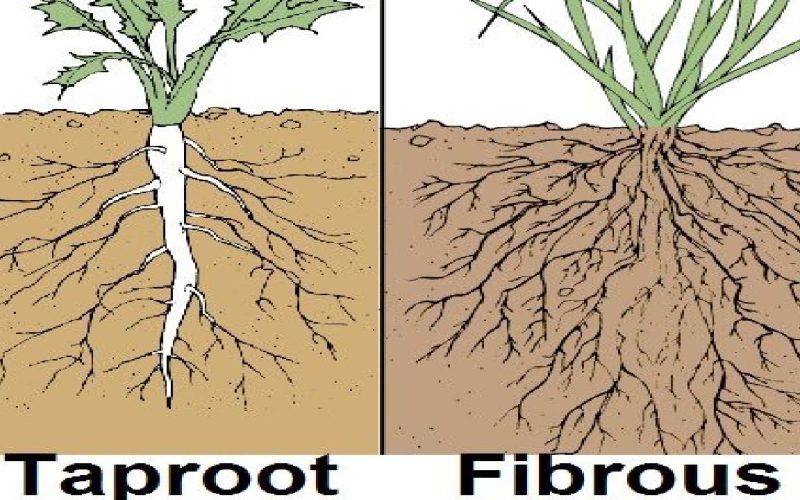The root is the part of a plant that attaches to the ground or supports, usually underground, and transports water and nutrients to the rest of the plant through numerous branches and fibers.
Its primary functions are plant anchorage, water, dissolved mineral absorption, and reserve food storage.
In this article, we will explain the different types of roots.
What are Roots?
Roots are the non-leafy portion of a plant’s body that lacks nodes. It is the organ found beneath the soil’s surface.
Roots can also be aerial, meaning they grow above the ground, or aerated, meaning they float on the water’s surface.
The roots provide adequate water and nutrients for the growth of the stems and leaves.
When a seed germinates, the primary root, or radicle, is the first organ to emerge.
It anchors the seedling by growing downward into the earth.
With gymnosperms and dicotyledons, the radicle transforms into a taproot (angiosperms with two seed leaves).
It develops downward while side roots spread out to create a taproot system.
The taproot also serves as a food storage mechanism in some plants, such as carrots and turnips.
Below are the lists of the different types of roots.
Different Types of Roots
Plants have different types of roots depending on the type and species of plant. The major types are as follows:
1. Fibrous Roots
Fibrous roots are among the different types of roots that fall under the monocot plants, which have fibrous roots.
They originate from the stem and are thin, branching plants. These roots typically stretch out horizontally and develop near the surface.
They have several roots that are roughly the same size and have a cluster-like appearance.
The primary root is transient in the fibrous root system, and many roots have replaced it.
Fibrous roots do not penetrate the soil deeply, so they cannot provide a stable anchor for the plant.
One of the characteristics of fibrous roots is that they emerge from the stem’s base and are underground.
They exist as groups of various sizes, and adventitious roots also exist to replace the main root.
Many plants have a fibrous root system, including all monocotyledons, rice, wheat, maize, marigolds, and bananas.
2. Creeping Roots
One of the different types of roots is creeping roots. Plants with creeping roots have roots that do not delve deeply into the earth.
They are thin and extend far horizontally from the plant’s base. Creeping roots are common in trees.
A creeping plant spreads its roots from its main body irregularly as it grows low.
These are the plant’s anchor, food sources, and water access points. Other plants also grow in a creeping manner, but vines often do.
Other creeping plants include but are not limited to, creeping thyme, phlox, mint, bamboo, potentilla, strawberries, honeysuckle, plums, and wild roses.
3. Taproots
Taproots are also among the different types of roots that we can find taproots in the majority of dicot plants.
The radical is a direct extension of this root. Taproots, as opposed to fibrous roots, are not branches.
Instead, they are a single primary root penetrating deeply into the soil.
A taproot produces lateral branches (secondary and tertiary roots), eventually joining to form a taproot system.
Its branches grow in acropetal succession, meaning the longer and older ones grow at the base, and the newer, shorter ones grow near the primary root’s apex.
The taproot system offers a solid anchorage. This strong support is due to their deep penetration into the soil.
Examples of creeping roots include onion, rice, millet, and maize.
4. Adventitious Roots
Adventitious roots grow on the stem, leaf, or other body parts other than the plant’s usual basal root system, particularly the radicle or root branches.
They share the same similarities with fibrous roots. However, they may, however, be underground or aerial (above the ground).
Nevertheless, radicals can sprout from any part of the plant. They typically develop from leaves, stem nodes, and intermodal.
These roots may be thick, thin, or modified depending on the species.
Under stressful circumstances, such as waterlogging after floods, adventitious roots grow.
However, roses, branches, and leaf cuts can produce adventitious roots.
As a plant multiplies itself with adventitious roots, these propagative roots can boost its chances of survival.
Rice and mangroves, for example, produce constitutive adventitious roots.
This type of root growth occurs naturally in the plant’s life and is not triggered by any circumstance.
These plants have segmented stems that produce organized adventitious roots and develop adventitious roots in ordered segments.
5. Tuberous Roots
Tuberous roots are exceptionally thick roots that store a large amount of food to feed the entire plant.
However, they are fleshy, enlarging, and altered storage organs that differ from the stem.
These propagative roots reproduce by crown division, with each crown division having several buds and enough storage to produce a new plant.
A tuberous root is an enlarged fleshy root modified as a storage organ with shoots produced at one end and roots grown at the other.
However, a plant can have Tuberous roots in several herbaceous perennials.
Nevertheless, sweet potato is one example of a plant with tuberous roots.
6. Foliar Roots
Foliar roots are among the different types of roots. They form naturally from leaf veins or petioles due to a leaf injury.
The injured area develops new foliar buds, which give rise to these roots that allow new plants to grow.
Plant growth hormones can sometimes stimulate the plant to establish new foliar buds in the region where they can be applied.
However, they develop from petiole (e.g., Pogostemon, rubber plant, etc.) or leaf veins due to an injury.
Some foliar buds, such as Bryophyllum and Begonia, can produce foliar roots.
Conclusion
This article talked about some of the different types of roots.
We have been able to unfold the different types of roots and their examples; among them are the fibrous roots: rice, wheat, maize, and others.
However, Taproots, creeping, and tuberous roots are among the different types of roots.








